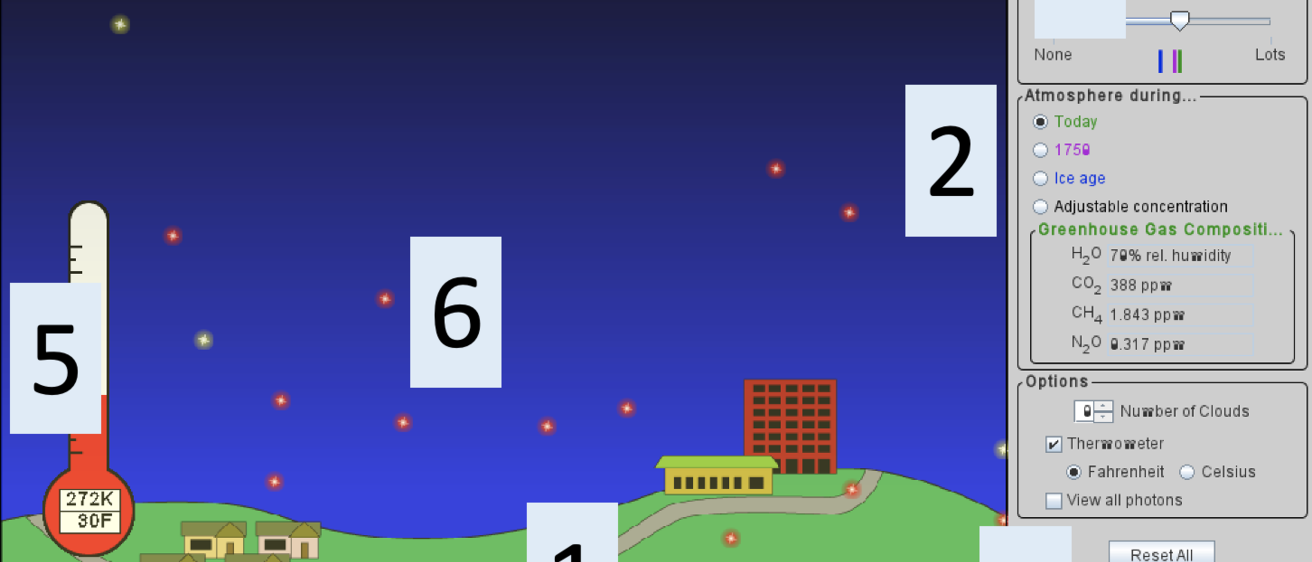
Breadcrumb
- Home
- Labs
- Foundational Labs
- Earth's Changing Climate
- Part 1: The Greenhouse Effect
Part 1: The Greenhouse Effect
Resources: PhET - The Greenhouse Effect

In the first part of today's lab, you will investigate the steps of the Greenhouse Effect. Examine Figure 1 at right. The Greenhouse Effect is comprised of multiple energy transfers. First, the Sun emits electromagnetic radiation (light) that interacts with the Earth's atmosphere and surface. Second, Earth's surface emits radiation that both escapes to space and interacts with Earth's atmosphere. Finally, Earth's atmosphere itself emits radiation that both escapes to space and interacts with the Earth's surface. Continue reading below to look at each of these energy transfers in more detail, as well as to examine the Greenhouse Effect as a whole.
Emission from the Sun
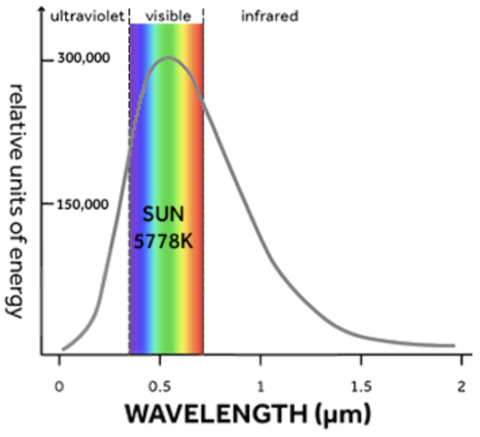
The Sun behaves as a blackbody and emits light at all wavelengths. A diagram of this emission is seen at left in Figure 2, with wavlength of ligth on the x-axis and relative flux on the y-axis, showing how much light is emitted by the Sun in each wavelength regime of the electromagnetic spectrum. This light leaves the Sun as is seen in panel [1] of Figure 1 above. Some of this light is reflected off the atmosphere. Some of this light passes through the atmosphere and is reflected off the Earth, passing through the atmosphere again and going back out into space. Some of this light is absorbed by the Earth. Some of this light is absorbed by Earth's atmosphere.
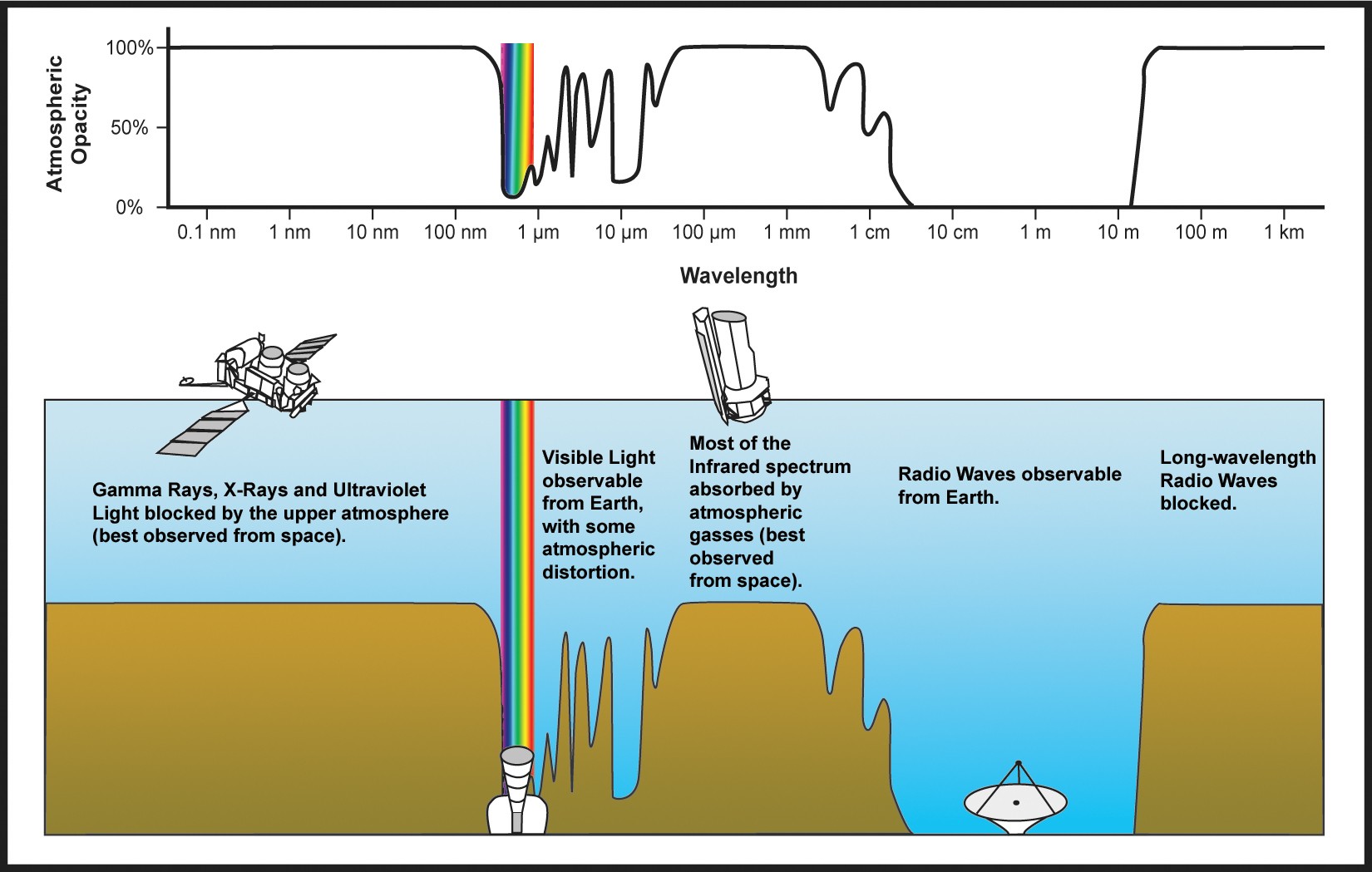
Determining what type of light can pass through the Earth's atmosphere and and what type of light cannot pass through Earth's atmosphere and is instead absorbed by the atmosphere is possible by examining a transmission spectrum of the Earth's atmosphere. A diagram of this absorption is seen at right in Figure 3, with wavelength of ligth on the x-axis and the relative amout of light that cannot pass through the Earth's atmosphere on the y-axis. As seen at the bottom of the figure, understanding the absorption spectrum of the Earth is not only useful for better understanding the Greenhouse Effect, but also for understanding the choice of putting certain telescopes on Earth and other telescopes in space.
PhET - The Greenhouse Effect - Photon Absorption Tab
Alternatively in your lab, to determine what type of light can pass through the Earth's atmosphere and and what type of light cannot pass through Earth's atmosphere and is instead absorbed by the atmosphere, you will also use an online demonstration that simulates the Earth's atmosphere. The atmosphere is made of molecular nitrogen (N2), molecular oxygen (O2), methane (CH4), carbon dioxide (CO2), and water vapor (H2O), among other molecules. In this first use of this simulation you will pass both visible and infrared light through the components of Earth's atmosphere to understand what the atmosphere transmits and what it absorbs (blocks). On the PhET website linked at the top of this lab page, click on the 'Photon Absorption' tab. Read below for details on the use of this simulation from the University of Colorado Boulder.
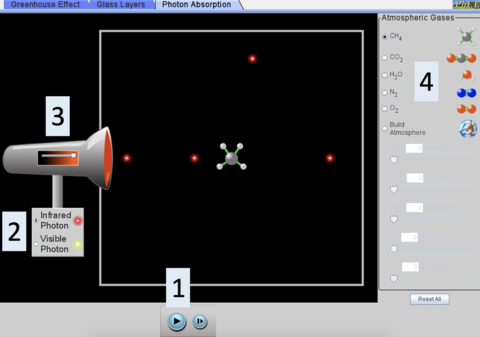
[1] Here you can Pause/Play the simulation.
[2] This toggle represents light coming from the Sun in the earlier questions in your lab and light coming from (reflected or emitted from) the surface of the Earth in the later questions in your lab. As applicable, select if you want to test a visible photon or an infrared photon coming from the Sun/Earth's surface.
[3] Move this slider all the way to the right to produce emission, or move it all the way to the left to turn off emission from the Sun/Earth's surface.
[4] You will need to study each molecule in Earth's atmosphere one-by-one. Select methane (CH4), carbon dioxide (CO2), water vapor (H2O), molecular nitrogen (N2), and molecular oxygen (O2) one after the other to test if your light photon will pass through this molecule when it is in Earth's atmosphere.
Emission from the Earth
The Earth emits light at all times, day and night. The electromagnetic radiation the Earth emits is not the type of light our eyes can see, however; this emission is invisible to humans. This light leaves the Earth as is seen in panel [2] of Figure 1 above. Some of this light passes through the atmosphere and escapes into space. Some of this light is absorbed by the Earth's atmosphere. Radiation from the Earth both passes through the atmosphere and is absorbed by the atmosphere because the atmosphere is partially transparent to the type of radiation Earth emits. You can convince yourself of this by again examining the Photon Absorption tab on the PhET - The Greenhouse Effect simulation and by examining Figure 3 above. In the PhET simulation, you should set [2] to the type of light that is emitted by the Earth and set cycle through all molecules present in Earth's atmosphere using [4].
Emission from the Heated Atmosphere
Warming of the Earth from light from the Sun (as in panel [1]) and cooling of the Earth from emission of light in the form of heat from the Earth's surface (as in panel [2]) can natually balance; in fact this has been the homeostasis for the majority of natural history. A critical additional detail of the Greenhouse Effect is what follows. Light from the Sun in panel [1] emits infrared light and not just visible light, and this cannot pass through the greenhouse gases present the Earth's atomosphere, and so the infrared light from the Sun is absorbed by and warms the atmosphere. Because of this heating, Earth's atmosphere also releases light in the form of heat, diagrammed in panel [3] in Figure 1 above. Much of this escapes to space, but much of this is transfered back down to Earth's surface, heating it further. The more greenhouse gases present in Earth's atmosphere, the more the surface of the Earth is heated by the atmosphere as it absorbs more and more infrared light as it is constantly irradiated by the Sun. This complication of the Greenhouse Effect is key to understanding why the Earth is warming: light from the Sun is not just trapped by the atmosphere once it has been emitted from Earth's surface, but the heating of the atmosphere itself causes additional light in the form of heat to be transmitted down to Earth, above and beyond what comes from the trapping of the Earth's emitted light.
PhET - The Greenhouse Effect - Greenhouse Effect Tab
In this final part of Part 1, you'll take a step back and view the process of the Greenhouse Effect as a whole. On the PhET website linked at the top of this lab page, click on the 'Greenhouse Effect' tab. Read below for details on the use of this simulation from the University of Colorado Boulder.
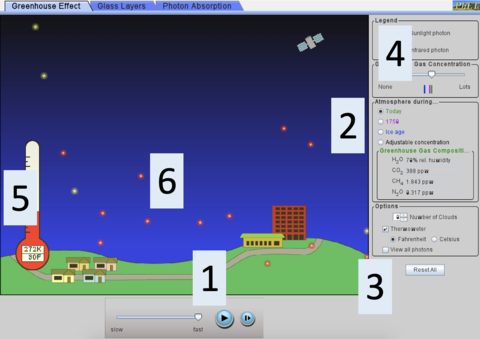
[1] Here you can Pause/Play the simulation.
[2] Using the 'Atmosphere during...' toggle, you can view how the Greenhouse Effect affected the Earth at different points in history.
[3] Increase the number of photons the simulation shows by selecting 'View all photons'. Checking this box is reccomended for completing the questions on your lab.
[4]-[6] When you switch between different 'Atmosphere during...' options, keep a close eye on how 'Greenhouse Gas Concentration', the thermometer, and the main display animation change. You will need to allow the simulation to settle for a while to see all changes.